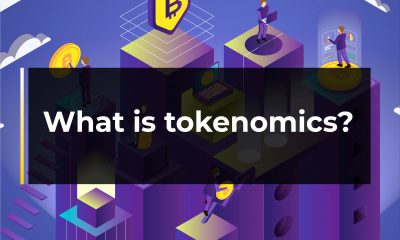Education
What is tokenomics?

Tokenomics is a new and innovative field that addresses how cryptocurrencies and blockchain-based platforms operate from an economic standpoint. By blending the words “token” and “economics,” the term “tokenomics” encompasses all aspects of token creation and management. The overall objective of token economics or “crypto-economics,” as it’s sometimes referred to, is to create cryptocurrency systems that align incentives among users on these networks, ensuring their long-term growth and success.
In simpler terms, token designers can create economies around digital tokens with unique properties and built-in functionality, such as transaction fees. This approach encourages demand for usage, which in turn drives up prices over time. Not only does this lead to financial benefits, it also fuels the adoption of the blockchain applications themselves.
Tokenomics is a multifaceted field that aims to facilitate the adoption and usage of a network while minimizing market manipulations and inflationary tendencies to protect users.
It encompasses various elements such as governance structure, transaction fees, and smart contract architecture, all designed with specific objectives in mind to create sustainable network effects. By aligning incentives for all stakeholders, tokenomics ensures that the platform functions optimally while prioritizing user interests.
While investors often focus on a cryptocurrency’s technology, it’s the tokenomics that can make or break a project. Well-designed token economics can increase liquidity and incentivize users and investors, while poorly designed tokens can lead to project failures due to lackluster engagement.
Don’t overlook the importance of evaluating a cryptocurrency’s economics. With the competitive nature of today’s crypto landscape, analyzing token models and identifying potential pitfalls early on can help transform your project from a mediocre endeavor to a successful venture.
Tokenomics, the study of supply and demand dynamics in cryptocurrency, is a critical component of any digital asset project.
Limited supply tokens are more valuable than those with an unlimited quantity. When there is scarcity of a desired asset, it drives demand higher and increases the potential for price appreciation.
Moreover, a token’s utility and benefits can influence buyers to pay higher prices leading up to equilibrium – the point at which both the buyer and seller find the exchange rate to be fair. This balance reflects perceived risk-reward ratios based on a thorough evaluation of the token economy and all relevant market conditions.
What to expect in designing tokenomics
The design of a blockchain-based project’s token economics is crucial because it dictates the incentives and behaviors within its ecosystem through token distribution, allocation, utility, and functionality. In the world of tokenomics, you can expect to find elements such as:
- Token distribution & allocation
Token creation involves specifying the initial or total supply, then distributing them to various stakeholders based on agreed terms. These include developers, founders, investors, and early adopters.
- Token utility & functionality
Tokens have different purposes based on whether they’re for fungible or non-fungible assets. Common uses include staking rewards to reduce volatility and voting rights proportional to holdings for governance control. Projects can also require ownership stake representation by locking some amount until redemption times, ensuring longer-term engagement from community members.
- Token economics & incentives
Token economics is the study of token function and value within a network. Tokens’ values depend on supply/demand dynamics, their utility in an ecosystem (transactions, access, governance), and incentives like staking rewards, transaction fee discounts, and voting power. With proper incentive design, crypto companies can build ecosystems rewarding user participation and long-term holding.
- Governance & decision-making in projects
Governance is how decisions are made within an organization or community. In projects, it’s about key areas like budgets and timelines. Token holders can participate via voting or consensus-based approaches. Effective governance enhances transparency and accountability, encouraging broad participation for a balanced representation.
Closing thoughts
Tokenomics is vital to blockchain success. A well-designed token economy ensures sustainable projects that attract users and investors. Companies must consider factors like fair initial allocation, proper supply-demand balance, and inclusive governance structures for strong economies within ecosystems. Developers who create well-designed token economics benefit everyone by offering solid incentives aligned with network health/growth goals.
Read also: What is an Initial DEX Offering (IDO)?

























76 Comments